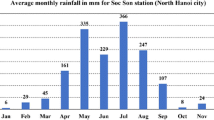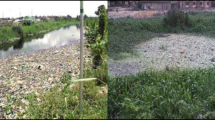Abstract
The mining exploitation of metallic sulphides, together with the activities associated to the mineral treatment and smelting, when maintained through centuries due to the wealth of the ores, generate important accumulations of wastes in structures of different kind of tailing dams and ponds, for instance. When no previous corrective steps are taken, as usually happens in old exploitations, this means a serious risk of environmental pollution, due to the mobilisation of heavy metals. The present study has been carried out in a mining district, actively exploited during the last two millennia, that was the first world’s producer of lead during some periods (Linares-La Carolina, southern Spain). In this district, the mining activity was associated to a philonian network of metallic sulphurs and ended by the 1980s of the past century. The ancient mining operations, mostly subterranean, have generated large accumulations of residues without any prior corrective action. Therefore, this work intends to characterise these mining dams and determine the influence of these mining wastes on the quality of surface and ground waters. With this goal, three structures that store the mining refuse of different mineralogical origin have been selected. First, a geochemical characterisation of the soil was performed in the area surrounding each of the structures. In all cases, high levels of trace elements (including Pb, Zn, Cu, Cd, Mn, As, Sb and Ba) were observed. A hydrochemical study revealed the mobilisation through the aqueous medium of certain contaminants from the leachate of these ancient accumulations; these contaminants will flow to the streams that drain the area or to the aquifers of the sector. The internal characterisation of these structures was performed with geophysical techniques, specifically electrical resistivity imaging (ERI). The six generated resistivity models have allowed the identification of the morphology of the structures, variations in the vertical and horizontal distribution of the deposited material, fracture zones, water content and reload–unload zones and the contact of the mining wastes with the substrate. Thus, the ERI study confirms the lack of impermeabilisation measures for the terrain in the spill zones in all three cases, which indicates a high risk of contamination of the soil and waters. The obtained images also permit the identification of the ideal positions to conduct future borehole controls.





Similar content being viewed by others
References
Adamo, P., Dudka, S., Wilson, M. J., & McHardy, W. J. (1996). Chemical and mineralogical forms of Cu and Ni in contaminated soils from the Sudbury mining and smelting region. Canadian Environmental Pollution, 91, 11–19.
Auken, E., Jørgensen, F., & Sørensen, K. I. (2003). Large-scale TEM investigation for groundwater. Exploration Geophysics, 34, 188–194.
Azcárate, J. E. (1977). Mapa geológico y memoria explicativa de la hoja n° 905 (Linares) del mapa Geológico de España, escala 1:50.000. Instituto Geológico y Minero de España.
Azcárate, J. E., & Argüelles, A. (1971). Evolución tectónica y estructuras filonianas en el distrito minero de Linares. Congreso Hispano-Luso-Americano de Geología Económica, Madrid, Tomo I, Sección 4, pp. 17–32.
Caputo, R., Piscitelli, S., Oliveto, A., Rizzo, E., & Lapenna, V. (2003). High-resolution resistivity tomographies in active tectonic studies. Examples from the Tyrnavos Basin, Greece. Journal of Geodynamics, 36, 19–35.
Caputo, R., Salviulo, L., Piscitelli, S., & Loperte, A. (2007). Late quaternary activity along the Scorciabuoi Fault (Southern Italy) as inferred from electrical resistivity tomographies. Annals of Geophysics, 50, 213–224.
Castelló, R., & Orviz, F. (1976). Mapa y memoria explicativa de la hoja n° 884 (La Carolina) del mapa Geológico de España, escala 1:50.000. Instituto Geológico y Minero de España.
Clesceri, S., Greenberg, E., & Rhodes, R. (1989). Standard methods for the examination of water and waste water (17th ed., pp. 22–45). Washington: American Public Health Association.
Colella, A., Lapenna, V., & Rizzo, E. (2004). High-resolution imaging of the High Agri Valley Basin (Southern Italy) with electrical resistivity tomography. Tectonophysics, 386, 29–40.
Contreras, F., & Dueñas, J. (2010). La minería y la metalurgia en el Alto Guadalquivir: Desde sus orígenes hasta nuestros días. Instituto de Estudios Giennenses. Diputación de Jaén.
Davis, B. E. (1983). Heavy metal contamination from base metal mining and smelting: implications for man and his environment. In I. Thornton (Ed.), Applied environmental geochemistry (pp. 425–650). London: Academic.
Fontboté, J. M. (1982). Mapa geológico y memoria explicativa de la hoja 70 (Linares) del mapa Geológico de España, escala 1:200.000. Instituto Geológico y Minero de España.
Gómez-Ortiz, D., Martín-Velázquez, S., Martín-Crespo, T., De Ignacio-San José, C., & Lillo, J. (2010). Application of electrical resistivity tomography to the environmental characterization of the abandoned massive sulphide mine ponds (Iberian Pyrite Belt, SW Spain). Near Surface Geophysics, 8, 65–74.
Griffiths, D. H., & Barker, R. D. (1993). Two-dimensional resistivity imaging and modelling in areas of complex geology. Journal of Applied Geophysics, 29, 211–226.
Gutierrez-Guzmán, F. (2007). Minería en sierra morena. Granada, Jaén y Málaga: Ilustre Colegio de Ingenieros Técnicos de Minas de Linares.
Gutiérrez-Guzmán, F. (1999). Las minas de Linares. Apuntes históricos. Ilustre Colegio Oficial de Ingenieros Técnicos de Minas de Linares.
Hidalgo, M. C., Benavente, J., El Mabrouki, K., & Rey, J. (2006). Estudio hidroquímico comparativo en dos sectores con minas abandonadas de sulfuros metálicos: Distrito de Linares-La Carolina (Jaén). Geogaceta, 39, 123–126.
Hidalgo, C., Rey, J., Benavente, J., & Martínez, J. (2010). Hydrogeochemistry of abandoned Pb sulphide mines: the mining district of La Carolina (southern Spain). Environmental Earth Sciences, 61, 37–46.
Improta, L., Ferranti, L., De Martini, P. M., Piscitelli, S., Bruno, P. P., Burrato, P., Civico, R., Giocoli, A., Lorio, M., D’Addezio, G., & Maschio, L. (2010). Detecting young, slow-slipping active faults by geologic and multidisciplinary high-resolution geophysical investigations: a case study from the Apennine seismic belt, Italy. Journal of Geophysics Research, 115, B11307. doi:10.1029/2010JB000871.
Kuo, S., Heilman, P. E., & Baker, A. S. (1983). Distribution and forms of copper, zinc, cadmium, iron and manganese in soils near a copper smelter. Soil Sciences, 135, 101–109.
Li, X. D., & Thornton, I. (1993). Multi-element contamination in soil and plant in the old mining area, O.K. Applied Geochemistry, S2, 51–56.
Li, X. D., & Thornton, I. (2001). Chemical partitioning of trace and major elements in soils contaminated by mining and smelting activities. Applied Geochemistry, 16, 1693–1706.
Lillo, J. (1992). Geology and geochemistry of Linares-La Carolina Pb-Ore field (Southeastern border of the Hesperian Massif). Ph. D. thesis, University of Leeds.
Loke, M. H., & Barker, R. D. (1996). Rapid least-squares inversion of apparent resistivity pseudosections by a quasi-Newton method. Geophysical Prospecting, 44, 131–152.
Loke, M. H., & Dahlin, T. (2002). A comparison of the Gauss–Newton and quasi-Newton methods in resistivity imaging inversion. Journal of Applied Geophysics, 49, 149–162.
Loredo, J., Ordóñez, A., Gallego, J. R., Baldo, C., & García-Iglesias, J. (1999). Geochemical characterization of mercury mining spoil heaps in the area of Mieres (Asturias, northern Spain). Journal of Geochemistry Exploration, 67, 377–390.
Maillet, G. M., Rizzo, E., Revil, A., & Vella, C. (2005). High resolution electrical resistivity tomography (ERT) in a transition zone environment: application for detailed internal architecture and infilling processes study of a Rhône River paleo-channel. Marine Geophysical Researches, 26, 317–328.
Martín-Crespo, T., Martín-Velázquez, S., & Gómez-Ortíz, D. (2010). A geochemical and geophysical characterization of sulfide mine ponds at the Iberian Pyrite Belt (Spain). Water, Air, and Soil Pollution. doi:10.1007/s11270-010-0595-6.
Martínez, J. (2002). Caracterización geoquímica y ambiental de los suelos en el sector minero de Linares. Ph.D. Thesis, Univ. Politécnica de Madrid.
Martínez, J., Llamas, J., De Miguel, E., Rey, J., & Hidalgo, M. C. (2007). Application of the Visman method to the desing of a soil sampling camping in the mining district of Linares (Spain). Journal of Geochemical Exploration, 92, 73–82.
Martínez, J., Llamas, J., De Miguel, E., Rey, J., & Hidalgo, M. C. (2008). Dertermination of geochemical background in a metal mining site: example of the mining distric of Linares (south Spain). Journal of Geochemical Exploration, 94, 19–29.
Martínez-Pagán, P., Faz Cano, A., Aracil, E., & Arocena, J. M. (2009). Electrical resistivity imaging revealed the spatial properties of mine tailing ponds in the Sierra Minera of Southeast Spain. Journal of Environmental and Engineering Geophysics, 14(2), 63–76.
Martínez-Pagán, P., Faz, A., Acosta, J. A., Carmona, D. M., & Martínez-Martínez, S. (2011). A multidisciplinary study for mining landscape reclamation. A study case on two tailing ponds in the Region of Murcia (SE Spain). Physics and Chemistry of the Earth. doi:10.1016/j.pce.2011.02.007.
Pazdirek, O., & Blaha, V. (1996). Examples of resistivity imaging using ME-100 resistivity field acquisition system. EAGE 58th Conference and Technical Exhibition Extended Abstract, Amsterdam.
Perconing, E. (1971). Sobre la edad de la Transgresión del Terciario marino en el borde meridional de la Meseta, Congreso Hispano-Luso-Americano de Geología Económica, Madrid. Sección 1, pp. 309–319.
Sasaki, Y. (1992). Resolution of resistivity tomography inferred from numerical simulation. Geophysical Prospecting, 40, 453–464.
Store, H., Storz, W., & Jacobs, F. (2000). Electrical resistivity tomography to investigate geological structures of Earth’s upper crust. Geophysical Prospecting, 48, 455–471.
Sumanovac, F. (2006). Mapping of thin sandy aquifers by using high resolution reflection seismics and 2-D electrical tomography. Journal of Applied Geophysics, 59, 345–346.
Suzuki, K., Toda, S., Kusunoki, K., Fujimitsu, Y., Mogi, T., & Jomori, A. (2000). Case studies of electrical and electromagnetic methods applied to mapping active faults beneath the thick quaternary. Engineering Geology, 56, 29–45.
Tamain, G. (1972). Recherches géologiques et minières en Sierra Morena orientale (Espagne). Thesis Univ. Paris-Sud (Orsay). Trav. Lab. Géol. Struct. Appli. 91- Orsay, p 648.
Telford, W. M., Geldart, L. P., & Sheriff, R. E. (1990). Applied geophysics. Cambridge: Cambridge University Press. 770 pp.
Acknowledgements
This research was funded by the Spanish Ministry of Science and Innovation (project CGL2009-12396, co-financed FEDER) and by the Government of Junta de Andalucía (project RNM 05959).
Author information
Authors and Affiliations
Corresponding author
Rights and permissions
About this article
Cite this article
Martínez, J., Rey, J., Hidalgo, M.C. et al. Characterizing Abandoned Mining Dams by Geophysical (ERI) and Geochemical Methods: The Linares-La Carolina District (Southern Spain). Water Air Soil Pollut 223, 2955–2968 (2012). https://doi.org/10.1007/s11270-012-1079-7
Received:
Accepted:
Published:
Issue Date:
DOI: https://doi.org/10.1007/s11270-012-1079-7




